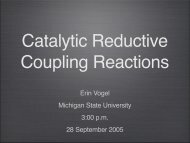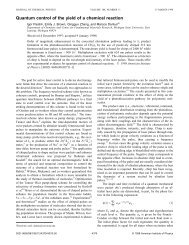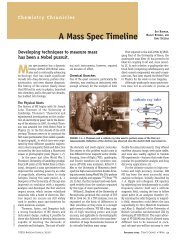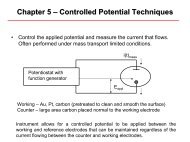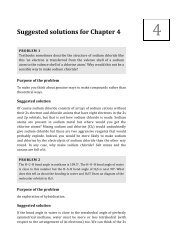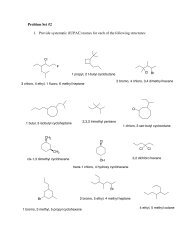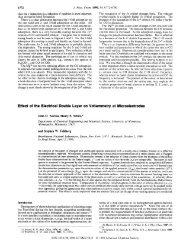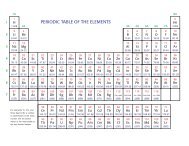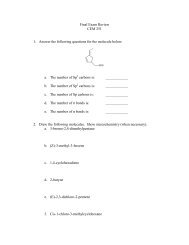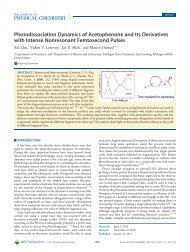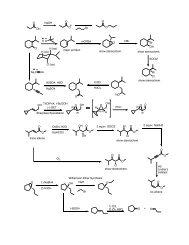High-Vacuum Pumps in Mass Spectrometers
High-Vacuum Pumps in Mass Spectrometers
High-Vacuum Pumps in Mass Spectrometers
Create successful ePaper yourself
Turn your PDF publications into a flip-book with our unique Google optimized e-Paper software.
............................. MASS SPECTROMETRY FORUM .............................Figure 2. Components of a turbomolecularpump.ecules. Repeated collisions move theresidual gas molecules toward the regionof higher pressure at the bottom of thediffusion pump. At the ejector jet, thepressure (300–500 mTorr) is such thatthe rough pump attached to the forel<strong>in</strong>ecan capture and exhaust the residual gasmolecules to the atmosphere.The work<strong>in</strong>g fluid used <strong>in</strong> diffusionpumps is a low-vapor-pressure hydrocarbonfluid such as Octoil, Convoil, or Santovac5 (all proprietary product names),or a silicone oil fluid such as DC 702, DC704, or DC 705 (also proprietary). Therequisite characteristics of the work<strong>in</strong>gfluid are an appropriate vapor pressureand chemical <strong>in</strong>ertness. The ultimate vacuumpressure atta<strong>in</strong>able with a diffusionpump is directly related to the vapor pressureof the work<strong>in</strong>g fluid; the lower thevapor pressure, the lower the ultimatevacuum. Of course, a lower vapor pressuremeans that a higher boiler temperatureis needed to evaporate the fluid andachieve a pump<strong>in</strong>g action.The chemical <strong>in</strong>ertness is important ongeneral pr<strong>in</strong>ciples, but also especiallydur<strong>in</strong>g the vent and pumpdown cyclesequences, and especially if the propersequences are not followed (5).Hydrocarbon-based oils will crack and oxidizeto tar if exposed to air when hot.The resultant tar coat<strong>in</strong>g the boiler of adiffusion pump and clogg<strong>in</strong>g the annularjets is difficult to remove. An abused silicone-basedoil will crystallize <strong>in</strong> theboiler; the crystals are strik<strong>in</strong>g <strong>in</strong> appearance,but the residue is often impossibleto remove, and the entire pump may needto be replaced.Backstream<strong>in</strong>g is a term that refers tothe migration of work<strong>in</strong>g fluid out of thediffusion pump <strong>in</strong>to the ma<strong>in</strong> vacuumchamber. Backstream<strong>in</strong>g occurs whenthe operat<strong>in</strong>g pressure of the diffusionpump is too high, and the net downwardmotion of the work<strong>in</strong>g fluid moleculescannot be reta<strong>in</strong>ed. The gas molecule motionsbecome randomized, and the work<strong>in</strong>gfluid molecules diffuse back <strong>in</strong>to thema<strong>in</strong> vacuum chamber, coat<strong>in</strong>g the relativelycool metal surfaces that they eventuallyencounter. A vacuum systemdisassembled for <strong>in</strong>spection will often exhibita th<strong>in</strong>, greasy-look<strong>in</strong>g film on <strong>in</strong>teriormetal surfaces; this is the result ofbackstream<strong>in</strong>g of a hydrocarbon-basedwork<strong>in</strong>g fluid. Backstream<strong>in</strong>g occurs to asmall degree even <strong>in</strong> normal operationbut is m<strong>in</strong>imized by the use of cold capsor cold traps.The aftermath of a vacuum accident —the un<strong>in</strong>tentional or too-rapid vent<strong>in</strong>g of a“hot” system — will be a thorough dispersalof work<strong>in</strong>g fluid throughout the massspectrometer, and therefore the need fora lengthy, <strong>in</strong>volved, and complete clean<strong>in</strong>gand parts replacement, <strong>in</strong> addition toa rejuvenation of the diffusion pump itself.The proper vent cycle <strong>in</strong>cludes acooldown for the diffusion pump oil beforevent<strong>in</strong>g (30–60 m<strong>in</strong>). A warm-uptime is also required dur<strong>in</strong>g the pumpdowncycle for the system to reach itsfull pump<strong>in</strong>g speed. The ability ofturbomolecular-pumped systems to cyclefrom atmosphere to work<strong>in</strong>g vacuum <strong>in</strong> ashorter time is an advantage <strong>in</strong> some situations,but the <strong>in</strong>itial cost of a diffusionpumpedsystem is lower. Costs of electricityand cool<strong>in</strong>g water required fordiffusion pump operation also have to befigured <strong>in</strong>to a cost-based decision betweenthe two approaches to achiev<strong>in</strong>ghigh vacuum.The turbomolecular pump must alsoimpose a net directional motion to theresidual gas molecules <strong>in</strong> the vacuum system.The turbomolecular pump does soby repeated collisions of the residual gasmolecules with rotat<strong>in</strong>g blades of a turb<strong>in</strong>erotor (Figure 2). The blades of therotor sp<strong>in</strong> at speeds of 20,000–50,000rpm; the edge speed of the rotors approachesthe velocities of the residual gasmolecules themselves. When a collisionoccurs, a direction is imparted to the motionof the residual gas molecules towarda region of higher pressure and towardthe pump exhaust (aga<strong>in</strong>, a rough pumpoperat<strong>in</strong>g on the forel<strong>in</strong>e).There are several stages of sp<strong>in</strong>n<strong>in</strong>grotors, with the angles of the rotor bladeschang<strong>in</strong>g along the profile of the pumpfrom <strong>in</strong>let to exhaust, as shown <strong>in</strong> Figure2. Residual gas-phase molecules aremoved toward the exhaust and then areremoved from the forel<strong>in</strong>e by the roughpump. <strong>High</strong>er molecular mass gas moleculesare pumped more efficiently by theturbomolecular pump than lower molecularmass molecules; therefore, there isvery little backstream<strong>in</strong>g of lubrication oilmolecules <strong>in</strong>to the ma<strong>in</strong> vacuum chamber.The turbomolecular pump has thecharacteristic of be<strong>in</strong>g a clean pump<strong>in</strong>gsystem with no backstream<strong>in</strong>g.Clearly there is no heater to warm upor cool down <strong>in</strong> a turbomolecular pump.A system so pumped can be vented to atmosphereand then pumped down morequickly than can a diffusion-pumped system(m<strong>in</strong>us the use of isolation gatevalves <strong>in</strong> the latter, which decrease the effectivepump<strong>in</strong>g speed). Diffusion pumpsmust be mounted at the bottom of a vacuumchamber, and <strong>in</strong> a vertical orientationso that gravity can return the condensedwork<strong>in</strong>g fluid to the boiler. Aturbomolecular pump can be mounted <strong>in</strong>any orientation relative to the vacuumchamber. There is residual vibration froma turbomolecular pump, so the mount<strong>in</strong>gsystem often <strong>in</strong>cludes an <strong>in</strong>tegral vibrationisolation device. F<strong>in</strong>ally, although thepump<strong>in</strong>g speed is not as high as with diffusionpumps, the smaller size of the turbomolecularpump is often an advantage<strong>in</strong> today’s smaller mass spectrometers,and there is no need for a cool<strong>in</strong>g waterconnection.<strong>Mass</strong> spectrometrists seem to pay lessattention to vacuum-related issues todaythan <strong>in</strong> the past. <strong>High</strong> vacuum has becomeeasier to atta<strong>in</strong>, pumps are more reliable,and pump<strong>in</strong>g systems are moreautomated. In vacuum, as with so muchelse, the modern mass spectrometrist exhibitsthe habit of deferr<strong>in</strong>g or ignor<strong>in</strong>gma<strong>in</strong>tenance. And, as with much else,there is an ultimate cost to be paid for sodo<strong>in</strong>g. In a mass spectrometer, the cost isdecreased performance <strong>in</strong> terms of lowersensitivity or lower resolution; mass spectrathat deviate from those measured andarchived under more ideal conditions;and shorter lifetimes for replaceableitems such as electron multipliers, ionizationgauges, and source filaments. Therough pump has the f<strong>in</strong>al task of exhaust-16 SPECTROSCOPY 16(5) MAY 2001 www.spectroscopyonl<strong>in</strong>e.com



